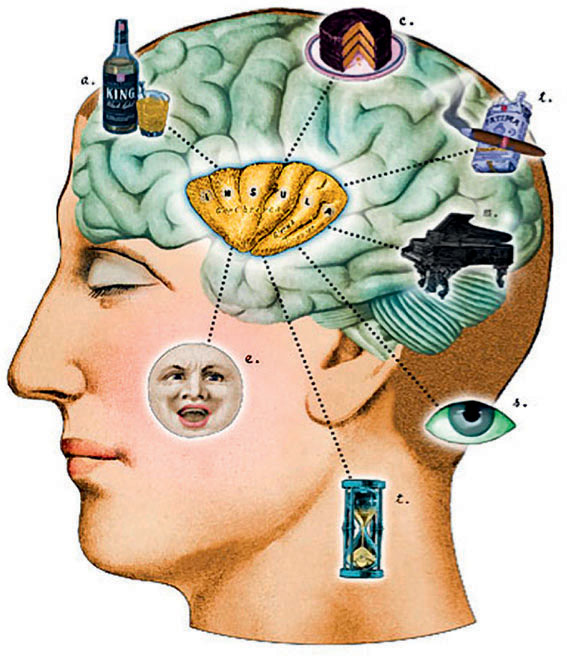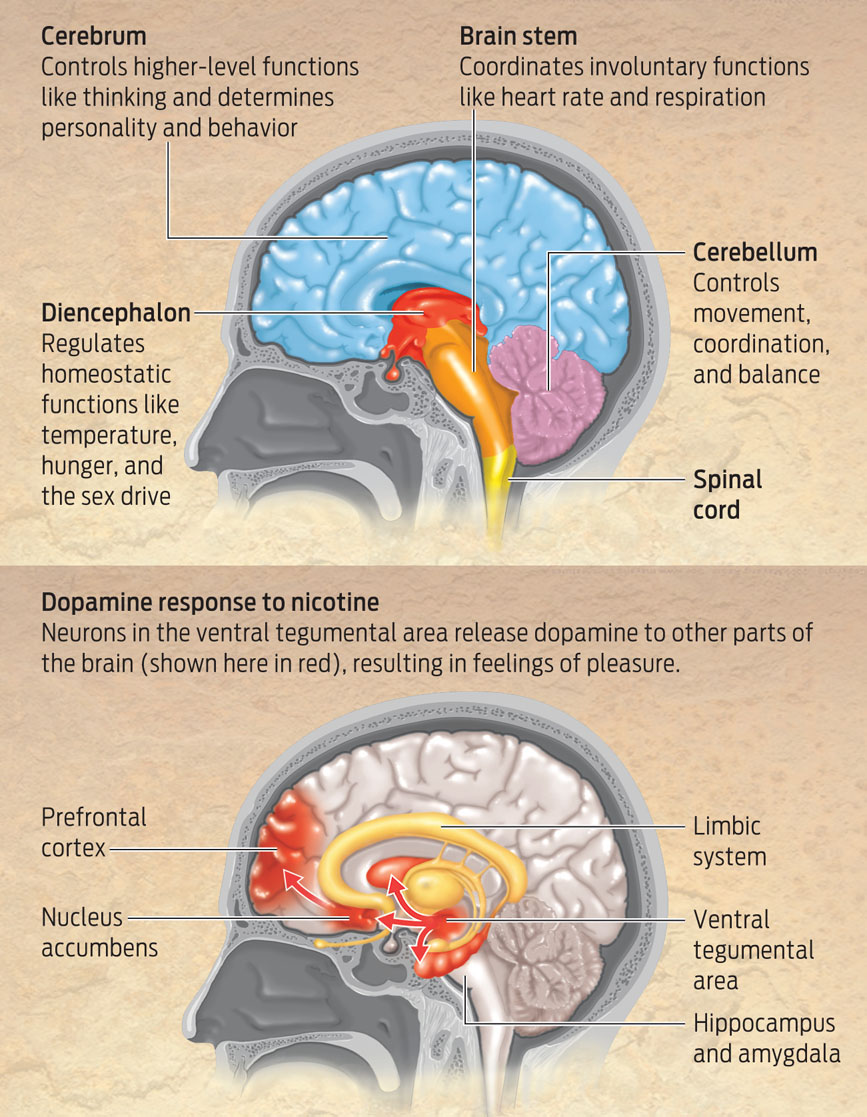THE ANATOMY OF ADDICTION
Neurons communicate not only to move muscles that control limbs but also to solidify thoughts and lay down memories. This constant chatter within the nervous system is the way in which the brain grows and adapts to new environments and learns new tasks. The great capacity that humans have for conscious thought is a function of the sheer number of neurons found in the human brain: approximately 100 billion.
CEREBELLUM The part of the brain that processes sensory information and is involved in movement, coordination, and balance.
But the brain isn’t just an undifferentiated mass of neurons; like any organ, it has specialized regions that perform distinct functions. For example, one part of the brain processes visual information, another specializes in hearing.
BRAIN STEM The part of the brain that is closest to the spinal cord and which controls vital functions such as heart rate, breathing, and blood pressure.
Scientists typically divide the brain into four major regions: cerebellum, brain stem, diencephalon, and cerebrum. The cerebellum, located in the rearmost portion of the brain, controls movement, coordination, and balance. The brain stem, at the base of the brain, coordinates involuntary functions like reflexes, heart rate, and breathing. The diencephalon, located above the brain stem, regulates homeostatic functions like body temperature, hunger, thirst, and the sex drive. The cerebrum is the largest part of the brain, sitting right on top. Its outer layer, the cerebral cortex, is the seat of our more advanced brain functions, including perception and thinking, and gives us our distinct personalities and most human characteristics. Its inner portion transmits signals, in the form of action potentials, from the cortex to various brain regions and to other parts of the body. The cerebrum is made up of about 10 billion neurons and is divided into left and right hemispheres, with each hemisphere divided into four lobes. Each lobe processes a variety of functions, including smell, hearing, speech, and vision.
DIENCEPHALON A brain region located between the brain stem and the cerebrum that includes the thalamus and hypothalamus and regulates homeostatic functions like body temperature, hunger, thirst, and the sex drive.
CEREBRUM The region of the brain that controls intelligence, learning, perception, and emotion.
CEREBRAL CORTEX The outer layer of the cerebrum, the cerebral cortex is involved in many advanced brain functions.
HIPPOCAMPUS A subregion of the brain involved in learning and memory.
AMYGDALA A subregion of the brain that processes emotions, especially fear and anxiety, and is the seat of emotional memories.
Within these large regions are subregions that are further specialized for carrying out certain functions. The diencephalon, for example, includes the thalamus and hypothalamus, subregions important for regulating homeostasis (see Chapter 25). The cerebrum includes the hippocampus and amygdala–two important components of what is sometimes called the limbic system, the primary seat of our emotions and memories. (“Limbic” comes from the Latin limbus, which means “border”; the structures in this system lie along the border of the cerebrum and diencephalon.) Along with two nearby regions, the nucleus accumbens and the ventral tegumental area (VTA), the limbic system, which is stimulated during pleasurable activities, is a major region involved in addiction. It is this system that researchers sometimes refer to as the pleasure center or reward system of the brain.
DOPAMINE A neurotransmitter that is involved in conveying a sense of pleasure in the brain.
In 1954, psychologists James Olds and Peter Milner of McGill University provided the first evidence for the existence of such a “pleasure center” in the brain. They implanted electrodes into the brains of rats–specifically in the VTA. The rats were then trained to press a lever that would administer a jolt of electricity through the electrode. The rats apparently found the experience intensely pleasurable because they would continue to press the lever without rest for up to 24 hours, as many as 5,000 times per hour!

Scientists now know that neurons in the VTA are one of the main sources of dopamine in the brain. When a smoker lights up, nicotine that reaches the brain stimulates the release of dopamine from neurons in the VTA. This dopamine floods other areas of the brain’s reward system, giving the smoker a pleasurable sensation (INFOGRAPHIC 29.5).
That drugs can affect the brain’s pleasure centers explains why they can be so hard to kick. It also explains why even addicts who successfully stop taking drugs for decades can relapse simply by being in an environment that conjures up memories of the drug. The tinkling of a whiskey glass, meeting an old drinking buddy, being in a bar or a room filled with smokers puffing away can be reminders powerful enough to lure former addicts back to their old ways.
